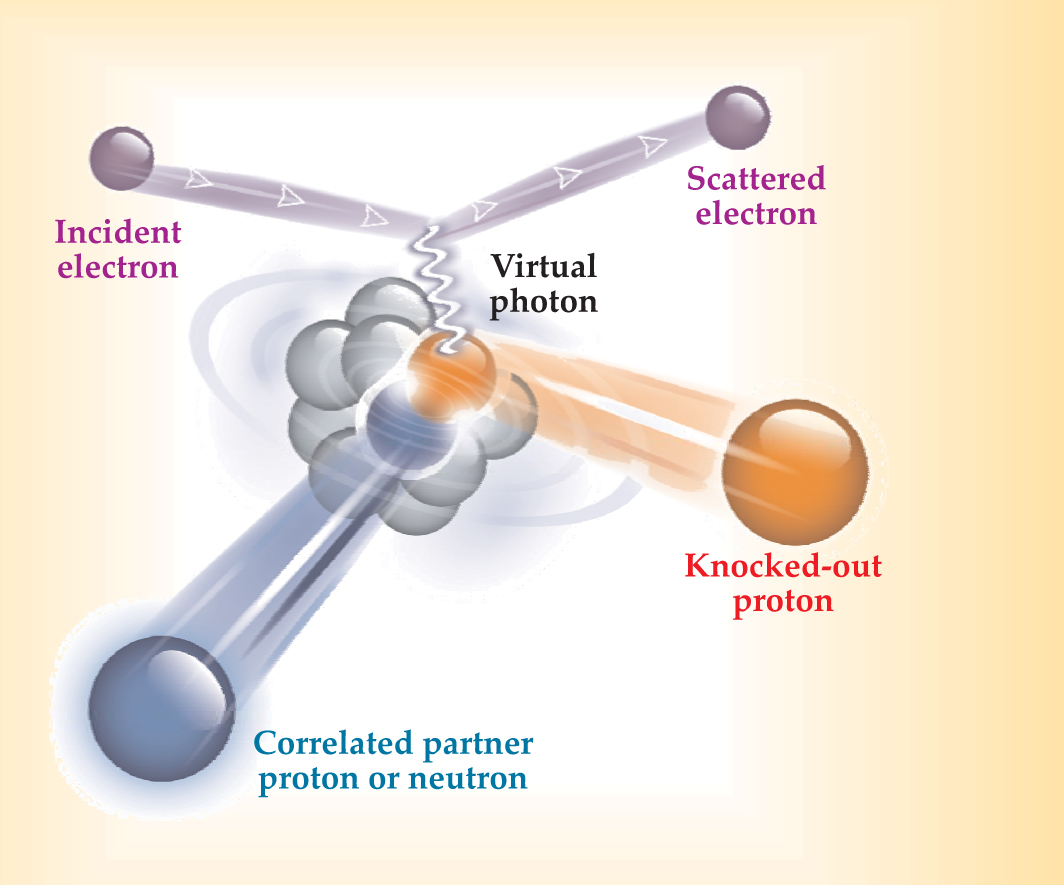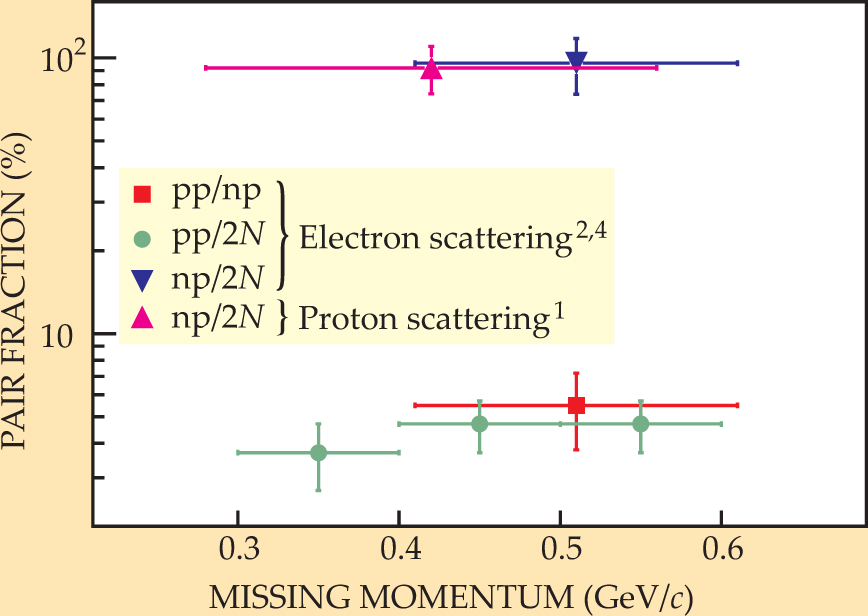Electron-scattering experiments resolve short-range correlations among nucleons
DOI: 10.1063/1.2962997
According to the shell model, the protons and neutrons—collectively known as nucleons—that make up nuclei move independently in discrete quantum orbits and are bound by an average potential created by their mutual attractive interactions. But that picture is too naive. In the 1980s, electron-scattering experiments that knocked protons from both valence and deeply bound nuclear orbitals found only 60–70% of the number predicted by the mean-field approximation.
At the time, some theorists attributed the difference to correlations between nucleons. A rich variety of low-energy nuclear phenomena, including collective rotations and vibrations, shape mixing, and superfluidity, are known to originate in correlations between nucleons separated by several femtometers. But those long-range correlations make up less than half the difference. Short-range correlations (SRCs), on the scale of a femtometer or less, can close the gap, but direct evidence for them has proven elusive. Still, physicists have surmised their presence for decades, not least because short-range repulsion between nucleons prevents the collapse of a nucleus.
One can think of SRCs as transient fluctuations in the local nuclear density when the wavefunctions of two energetic nucleons strongly overlap. For less than a trillionth of a femtosecond, the nucleons approach each other closely enough to form correlated pairs, with local densities close to what’s expected in the core of a neutron star. While short in time, those correlations are ever present, with a percentage of nucleons paired up at any given time. The development of high-energy accelerators has made observing such pairs possible, primarily because a probe’s wavelength can be made smaller than the nucleon-nucleon distance.
To resolve SRCs, an experiment must transfer to the nucleus momenta near 1 GeV/c, an amount larger than the characteristic Fermi momenta of nuclei. According to Mark Strikman, a theorist at the Pennsylvania State University momentum-transfer reactions can test two fundamental features of SRCs: First, the shape of the high-momentum component of the nucleon wavefunction is independent of the nuclear environment; in effect, the bare interaction in a pair is unmediated by the presence of other nucleons. And second, the ejection of one nucleon is accompanied by the ejection of its correlated partner with equal and opposite momentum, leaving the rest of the system nearly unaffected.
Two years ago Strikman, along with Eliezer Piasetzky (Tel Aviv University), Misak Sargsian (Florida International University), Leonid Frankfurt (Tel Aviv University), and John Watson (Kent State University), analyzed the data from a 2003 Brookhaven National Laboratory experiment using the AGS accelerator in which GeV protons were incident on a thin carbon foil. The team found the telltale signs of correlated pairing and a striking asymmetry in the data: Of the SRCs analyzed, the vast majority were neutron-proton pairs. 1
Now a collaboration of 64 scientists, Piasetzky and Watson among them, from 31 institutions around the world has published what may be the most direct observation yet of those asymmetric correlations. 2 Instead of firing protons at carbon-12, the new experiment fired electrons, which interact with nuclei not via the strong force but through an electromagnetic interaction. The much different probe captured the same SRC physics.
In concept the experiment is simple. An incident electron transfers a portion of its momentum through a virtual photon to a single proton in the 12C nucleus, as sketched in figure 1. In execution, it’s daunting. Preparation for the experiment, performed at the Thomas Jefferson National Accelerator Facility in Newport News, Virginia, spawned three PhD theses. Ramesh Subedi (Kent State), Ran Shneor (Tel Aviv), and Peter Monaghan (MIT) custom-built detector components, ran simulations to optimize the kinematics, and modified existing spectrometers to ensure they would actually work when sprayed with a 4.6-GeV electron beam of high luminosity (1038 cm −2 s−1). The experiment took years to build and three months to run, with scientists continually monitoring the accumulating data.

Figure 1. An energetic electron scatters off a carbon nucleus and transfers a fraction of its momentum to a proton through the exchange of a virtual photon. The momentum knocks the proton out of the nucleus. At the same time, another nucleon, although untouched in the exchange, is ejected with a signature that the initial state was in a short-range correlation.
(Courtesy of Anna Shneor.)

In the “triple-coincidence” experiment, three separate detectors were positioned to measure the momenta of the scattered particles with subnanosecond time resolution over a range of kinematic settings above the nucleons’ Fermi momenta. Two high-resolution spectrometers defined distinct proton knock-out events, while a third, affectionately called BigBite, caught correlated protons that recoiled over a wide cone of solid angles. Behind BigBite sat yet another detector comprising an array of scintillators to catch recoiling neutrons.
That unique arrangement of detectors allowed the Jefferson Lab team to present its data in the form of pair fractions (see figure 2). About 20% of nucleons in 12C form SRC pairs, a percentage consistent with 1980s-era spectroscopic results. And, of those, roughly 96% appear in the form of neutron–proton pairs, a confirmation of the BNL analysis.

Figure 2. The fractions of correlated-pair combinations, as measured from electron- and proton-scattering experiments. At momenta above 275 MeV/c nearly all of the nucleons N ejected from carbon-12 are correlated. The data reveal a roughly 20-to-1 predominance of neutron–proton (np) pairs over proton–proton (pp) ones. The red square plots the inverse, pp/np, and other data points plot the number of pp or np pairs over the total number of nucleon pairs. Missing momentum refers to the difference between the virtual photon’s momentum and that of the knocked-out proton. Horizontal bars signify the range of momentum averaged over, not uncertainties.
(Adapted from ref. 2.)

Tensor force
The interaction between two nucleons has two preeminent features: a strong repulsion at short distances, and a strong coupling between the nucleons’ spins and their spatial separation at distances greater than a femtometer. That tensor character is important for binding the proton and neutron in the deuteron and for making its ground state spherically asymmetric, in marked contrast to systems like the hydrogen atom, where the radial Coulomb attraction results in a spherical ground state.
The tensor force is also responsible for the prevalence of neutron–proton pairs over proton–proton and, by inference, neutron–neutron ones when the relative momentum between the nucleons in the pair is large. To obey the Pauli principle at such short range, two like nucleons must be antisymmetric under exchange of spins, while a neutron and proton pair can be symmetric in spin. The unlike nucleons can, like a compact deuteron, thus experience an attraction, while those of like nucleons cannot. 3 “It’s no surprise that tensor forces are behind the asymmetry we measure,” says Jefferson Lab physicist Douglas Higinbotham, “though the amount [of that asymmetry] is sure to constrain future nuclear-structure models.”
Piasetzky likens SRC pairs to “a poor man’s neutron star.” Indeed, the transient fluctuations that briefly pair up nucleons push their local densities to some five times their typical value of 0.16 nucleon/fm3. The Jefferson Lab collaboration argues that if neutron stars contain even the small 5–10% of protons that theorists think they do, the strong neutron–proton interactions will cause the momentum distributions of nucleons in the stars to differ from that of an ideal Fermi gas. The challenge is to understand the consequences.
Equally intriguing is how the structure of nucleons inside nuclei should change when densities are greater still and three-body or higher correlations emerge from the data. In a few years Jefferson Lab expects to upgrade its facility to one that can fire 12-GeV electrons at a nucleus. Eventually, comments Sargsian, experiments may reach a momentum-transfer regime in which nucleons lose their individual identities and dissolve into a sea of quarks. Currently, the short-range repulsion that preserves nucleon identity is a mystery. “Theorists now just draw it in by hand.”
References
1. E. Piasetzky et al., Phys. Rev. Lett. 97, 162504 (2006).https://doi.org/PRLTAO
10.1103/PhysRevLett.97.162504 2. R. Subedi et al., Science 320, 1476 (2008).https://doi.org/SCIEAS
10.1126/science.1156675 3. See R. Schiavilla et al., Phys. Rev. Lett. 98, 132501 (2007)https://doi.org/PRLTAO
10.1103/PhysRevLett.98.132501
and M. M. Sargsian et al., Phys. Rev. C 71, 044615 (2005).https://doi.org/PRVCAN10.1103/PhysRevC.71.044615 4. R. Shneor et al., Phys. Rev. Lett. 99, 072501 (2007).https://doi.org/PRLTAO
10.1103/PhysRevLett.99.072501
